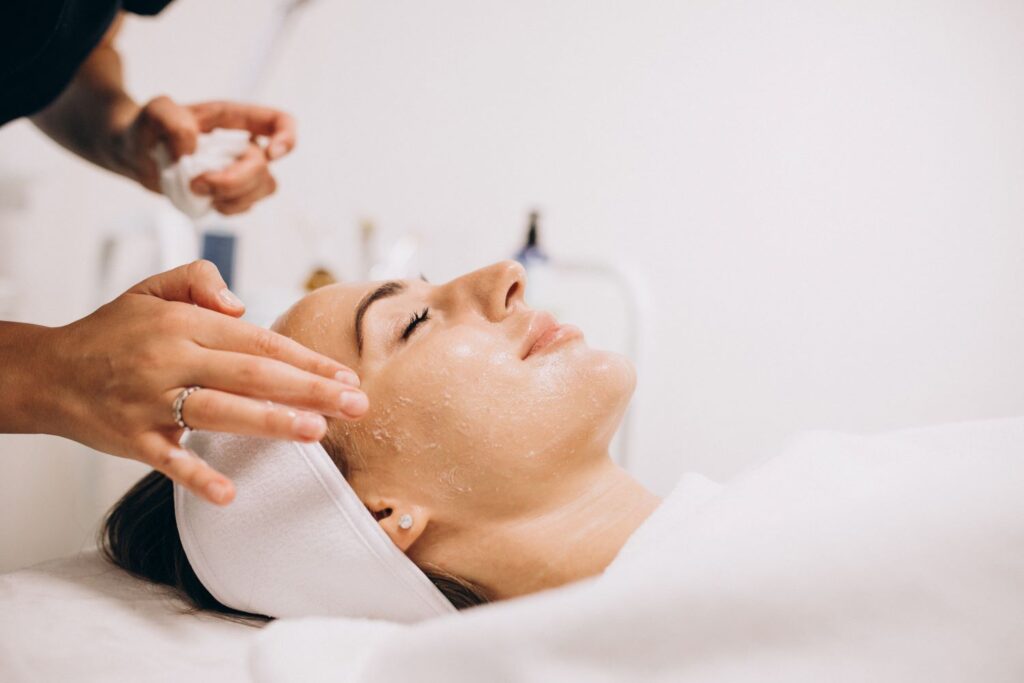
Chemical peel treatment is a procedure designed to enhance skin texture. During the treatment, a chemical solution is applied to the skin for a specific duration, depending on the strength of the peel. This solution exfoliates the skin, removing damaged cells and promoting the growth of fresh, healthier skin. As a result, the skin becomes smoother and rejuvenated, with improved texture and appearance.
The type of peel and its concentration is decided according to the underlying condition which is to be treated.The depth of peel in skin depends on its concentration. Let’s discuss the types of chemical peel and how they are important for our skin.
These peels typically use mild acids such as alpha-hydroxy acids (AHAs), including glycolic acid and lactic acid. They work by exfoliating the outermost layer of the skin (epidermis) to improve skin texture and appearance. Superficial peels are suitable for treating minor skin concerns such as fine lines, mild acne scars, uneven skin tone, and sun damage. Recovery time is minimal, with little to no downtime.
Medium-depth peels utilize stronger acids like trichloroacetic acid (TCA) or a combination of TCA peeling and other acids. They penetrate deeper into the skin, reaching the middle layers (dermis), to address moderate skin imperfections. Medium peels are effective for reducing the appearance of moderate wrinkles, acne scars, pigmentation irregularities, and sun damage. Recovery time is longer compared to superficial peels, with potential for redness, swelling, and peeling for several days to a week.
Deep peels use potent acids such as phenol or high-concentration TCA to deeply penetrate the dermis. They provide significant rejuvenation by targeting severe wrinkles, deep acne scars, and extensive sun damage. Deep peels require careful application and monitoring by a qualified dermatologist or plastic surgeon due to their intensity. Recovery can be substantial, with several weeks of redness, swelling, and peeling, but the results are often dramatic and long-lasting. These can be taken care of if showed to doctors in earlier stages itself. The downtime of any peel is mostly 4-6 days and again depends on the severity of peel and individual patient’s response
Post-procedure care is crucial after chemical peels as your skin undergoes rejuvenation and becomes temporarily sensitive. Follow these instructions:
Fact: Chemical peels can benefit individuals with a wide range of skin concerns, from mild to severe.
Fact: Chemical peels can be used on various parts of the body, including the neck, -chest, and hands, to address different skin concerns.
Fact: While chemical peels remove the outermost layer of skin, they can stimulate collagen production and promote skin thickening over time, leading to improved skin texture and elasticity.
Fact: While chemical peels are commonly used for cosmetic purposes, they can also be used to treat certain medical conditions such as acne, melasma, and precancerous skin lesions.
The duration of a chemical peel procedure can vary depending on the type and depth of the peel, but it generally takes about 30 minutes to an hour.
The number of treatments required depends on individual skin concerns and the type of peel used. Some people may see noticeable results after one treatment, while others may require multiple sessions for optimal outcomes.
Chemical peels can be customized to suit different skin types and concerns, but individuals with certain skin conditions or sensitivities may not be suitable candidates. It’s important to consult with a qualified skincare professional to determine candidacy.
Possible side effects of chemical peels include redness, irritation, peeling, and temporary changes in skin pigmentation. Serious complications are rare but may include infection, scarring, or allergic reactions.